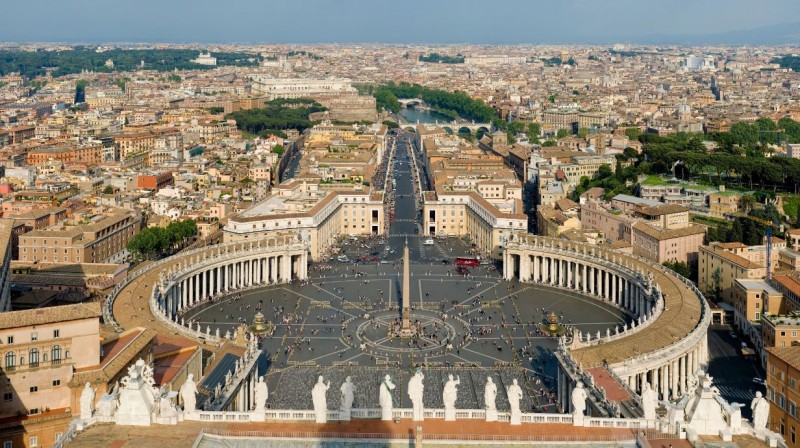
Vatican City, the world's smallest independent nation, holds immense significance due to its historical, political, and religious influence. This tiny city-state, covering a mere 44 hectares (110 acres), is the spiritual and administrative center of the Roman Catholic Church, making it a fascinating subject of exploration. In this article, we will delve into the unique aspects of Vatican City, its attractions, challenges, and its contributions to global affairs.
Geographic Overview
Size and Area
Vatican City's compact size makes it the tiniest sovereign nation globally, both in terms of land area and population. Nestled within the city of Rome, Italy, this walled enclave is a UNESCO World Heritage Site. Despite its small area, Vatican City boasts numerous awe-inspiring structures and artworks.
Location
Situated on the western bank of the Tiber River, Vatican City's strategic location in the heart of Rome has historical significance dating back centuries. Its proximity to the Vatican Hill, believed to be the burial place of St. Peter, led to the establishment of the city as the religious center of Catholicism.
Political and Religious Significance
Papal Authority
Vatican City is the residence of the Pope, the spiritual leader of the Roman Catholic Church. The Pope's authority extends beyond religious matters, as he is also the head of state for Vatican City. This dual role makes Vatican City unique, and its influence is felt globally, especially among the world's 1.3 billion Catholics.
Role in the World
Despite its small size, Vatican City plays a vital role in global affairs. The Holy See, which represents Vatican City, participates in diplomatic relations with numerous countries and international organizations. The Pope's pronouncements on various issues, such as peace, social justice, and human rights, carry substantial weight in the international community.
Unique Features
St. Peter's Basilica
One of the most iconic landmarks in Vatican City is St. Peter's Basilica. This magnificent Renaissance-era church is a masterpiece of architecture, art, and spirituality. Housing numerous precious artworks, including Michelangelo's Pietà, the basilica attracts millions of visitors annually.
Sistine Chapel
The Sistine Chapel, located within the Vatican Museums, is renowned for its awe-inspiring ceiling painted by Michelangelo. The frescoes depict scenes from the Book of Genesis and remain one of the greatest artistic achievements of all time.
Tourism and Visitors
Popular Attractions
Vatican City draws tourists from all corners of the globe. Besides St. Peter's Basilica and the Sistine Chapel, visitors can explore the Vatican Museums, which house a vast collection of art and historical artifacts. The Vatican Gardens and Apostolic Palace are also major attractions.
Cultural Impact
The city's rich cultural heritage and its role as a global pilgrimage site have a significant impact on the arts, history, and spirituality. The Vatican's contributions to the preservation of culture and knowledge are invaluable.
Challenges Faced by Vatican City
Limited Space and Expansion
Vatican City's limited size poses challenges for accommodating its growing administrative and operational needs. The city has carefully managed its urban development to preserve its historical and religious character.
Security and Sovereignty
Being an independent state in the heart of a bustling metropolis, Vatican City must maintain security and sovereignty. The Swiss Guard, established in the 16th century, is responsible for protecting the Pope and maintaining order within the city-state.
Vatican City and Diplomatic Relations
Holy See's Role in International Relations
Vatican City, through the Holy See, maintains diplomatic relations with various countries. The Pope acts as a spiritual and moral authority, often engaging in diplomatic efforts to promote peace and human rights.
Vatican's Diplomatic Corps
Vatican City has a unique diplomatic corps, consisting of clergy and laymen who represent the Holy See worldwide. This diplomatic network allows the Vatican to maintain a global presence and engage in dialogue with governments and organizations.
The Swiss Guard: Protectors of Vatican City
The Swiss Guard, with its distinctive Renaissance-style uniforms, serves as the official protectors of the Pope and Vatican City. Their history, traditions, and modern roles make them an intriguing aspect of Vatican City's security and culture.
Vatican City's Stance on Social Issues
Vatican City, guided by Catholic teachings, has a clear stance on various social issues, including human rights, poverty, and the sanctity of life. These positions often spark global debates and discussions.
Vatican Museums: Preserving Art and History
The Vatican Museums house an extensive collection of art and artifacts from various cultures and historical periods. Preserving and showcasing these treasures is essential to promote cultural understanding and appreciation.
The Vatican's Efforts for Global Peace and Justice
As a spiritual leader with global influence, the Pope advocates for peace, social justice, and environmental stewardship. Vatican City actively engages in initiatives and dialogues to address pressing global challenges.
Vatican City's Philatelic Contributions
Vatican City's postal service issues its postage stamps, often featuring religious themes, historical events, and artistic masterpieces. These stamps hold both philatelic and cultural value.
The Vatican Library: A Treasure Trove of Knowledge
The Vatican Library is one of the oldest and most significant libraries in the world. It houses an extensive collection of manuscripts, codices, and historical texts, making it a valuable resource for scholars and researchers.
Environmental Initiatives of Vatican City
Despite its small size, Vatican City takes initiatives to address environmental challenges. The Pope's encyclicals and environmental messages have inspired actions and discussions on global climate issues.
Vatican City, with its rich history, religious significance, and cultural contributions, remains an exceptional destination for pilgrims, tourists, and scholars alike. Its unique role in global affairs and diplomatic relations further solidifies its importance on the world stage.
A Guide to Choosing the Best Time to Visit Langkawi
Kandy: A Popular Travel Location
Exploring Washington: Discovering the State's Popular Destinations